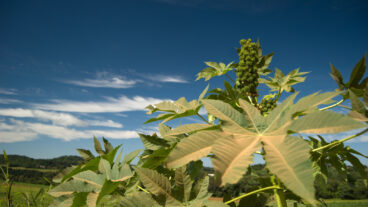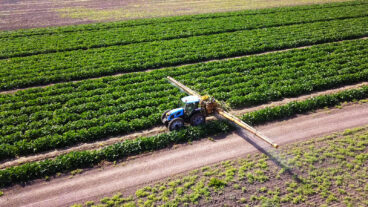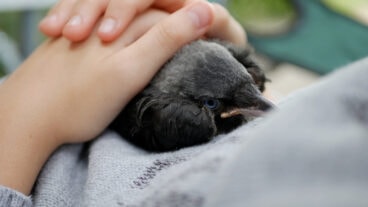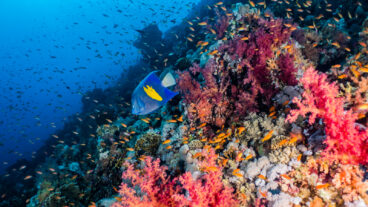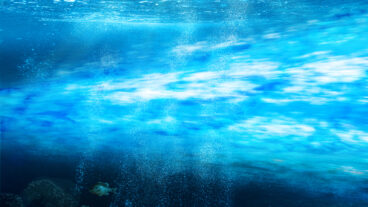Producing red algae – the Algatech facility at Kibbutz Ketura is now the world’s leading supplier of natural astaxanthin for human consumption.
When you imagine an algae or fish farm, a desert is probably not the first image that pops to mind.
But the desert in Israel has become a fertile ground for innovative – and profitable – aquaculture industries that are also benefiting health-conscious consumers in North America, Europe and Asia.
One such enterprise is located at Kibbutz Ketura in the heart of the Arava desert – about 35 miles north of the resort town of Eilat.
There is a reddish glow at the entrance of the kibbutz, and it’s not just from the rose-hued mountains. An array of brilliant red ‘tubes’ spreads out across the land like furrows in a field. The ‘crop’ being grown here is algae, better known as seaweed. The transparent, water-filled tubes contain millions of red flakes of micro-algae, called Haematococcus pluvialis. Produced by Algatechnologies Ltd (Algatech), these algae are nature’s number one source of astaxanthin, a carotenoid that is an important part of the diet of salmon, lobsters and many crustaceans, endowing them with their characteristic bright pink hue.
But astaxanthin is more than a fish feed. It’s also a powerful anti-oxidant increasingly recognized for its disease-fighting properties. It is taken as a dietary supplement and also used in cosmetics because of its ability to protect against UV radiation.
Thanks to the Algatech facility at Kibbutz Ketura, Israel is now the world’s leading supplier of natural astaxanthin for human consumption.
The facility, established in 1998, is based on the scientific research of Prof. Sammy Boussiba of Ben-Gurion University of the Negev, and has been producing astaxanthin in commercial quantities since 2003.
The flakes of Haematococcus pluvialis contain the largest concentrations of astaxanthin found in nature (some 40,000 parts per million, compared to salmon which contains from 5-15 ppm).
Astaxanthin is a free-radical scavenger that interferes with the production and build up of cancer cells, and plays an important role in enhancing the immune system.
Why haven’t we heard more about this important protector of human health?
“Astaxanthin is just getting the attention of the health industry. There is a time lag before the good science at the basis of a product results in public awareness,” Dr. Amir Drory, director of Research and Development at Algatech, told ISRAEL21c.
“At the moment astaxanthin is not that well known to the public, but in time, I think it will be the next Omega-3,” adds International Marketing Manager Efrat Kat, referring to the polyunsaturated fatty acid found in certain fish that has been implicated in reducing the risk of cancer. Kat and her colleagues at Algatech already take a 4-milligram daily dose of astaxanthin – the amount recommended by the US Food and Drug Administration.
A summary of research on the use of astaxanthin published in the journal Trends in Biotechnology (May, 2003) cited more than 60 research studies and patents, showing among other things that astaxanthin limits the expansion of cancer cells, acts as an anti-inflammatory agent, inhibits the increase of bad cholesterol, and discourages wrinkling.
At AlgaTech, pure cultures of algae are cultivated in a fully controlled and closed system of water. They are then transferred to a modular tube system and exposed to natural sunlight for the final and crucial reddening stage of the process.
“It is because of the sunlight that we chose this location,” says Kat. “We can operate all year long, summer and winter.
“By operating in a closed system – as opposed to open ponds – we prevent contamination and accumulation of metals,” explains Kat, who maintains that the company’s astaxanthin is the purest and highest quality on the market. “We use no additives and no chemicals – just purified water and sunlight.”
The end product is a biomass containing 3.5-4 percent asthaxanthin, which is then extracted at a facility in the US, and sold in North America, Europe and Asia mainly for use in nutraceutical and cosmetic products; a small amount is also used in organic fish feed.
About 97% of the astaxanthin on the market is synthetically produced from petrochemicals, notes Kat. The synthetic version may be adequate for fish feed, but it has no value for people, and is not even marketed for human consumption.
“Clinical trials have shown that only the natural version has beneficial health effects,” she notes.
Synthetic astaxanthin fetches $2000 a kilogram on the market, while the natural product is sold for over $7000 a kilo.
“We already need to expand our plant to keep up with the growing demand,” says Kat.
Astaxanthin is not the only aquaculture industry drawing on two of Israel’s natural resources: sunlight and scientific expertise. In a laboratory in Beersheva, the capital of the Negev desert, another red alga – produced through Israeli technology – forms the basis of LightSource, a new line of moisturizing products by cosmetic giant Estee Lauder. The technology is also based on the research of a team from Ben-Gurion University of the Negev (BGU).
“The algae yield a polysaccharide which dissolves into a gel,” explains Prof. Shoshana Arad, who heads the BGU team. “This gel is not only a superior lubricant, but also has anti-inflammatory and anti-irritating properties which makes it excellent for ophthalmic, joint and cosmetic applications.”
Its anti-oxidant and elastic properties – and its resistance to biodegradation – make it ideal for skincare, adds Arad. She and her team have also found that this alga has anti-viral activity; they are now examining its potential as a new antibiotic.
In the meantime, the red algae have yielded moisturizer, eye cream and lip gloss promising -“amazing brightness and freshness – even without makeup” – according Estee Lauder.
Other farms in the arid southern region of the country take advantage of abundant sunshine and subterranean sources of warm, brackish water to raise tropical ornamental fish.
Israel has long been an innovator in aquaculture. It was the first country to commercialize the production of tilapia, a tropical sweet water fish which originates in the Jordan and Nile Rivers, and is now raised – and consumed – all over the world.
The cooler northern part of Israel is dotted with fish ponds – over half of them devoted to tilapia production. Many utilize a unique method, pioneered by Israel, which involves raising the fish in dual-purpose water reservoirs. These reservoirs – which collect winter rain – are used for irrigating adjacent farmland and for raising fish, making the method very economical.
“It gives the farmer flexibility to divide water use between agricultural crops and aquaculture, depending on the market,” notes Itzhak Simon, an Agriculture Ministry expert, who instructs farmers all over the country on aquaculture.
So, despite an acute water shortage, aquaculture in Israel is thriving – thanks to cutting-edge research, an entrepreneurial spirit, and a generous dose of sunshine.







